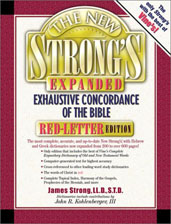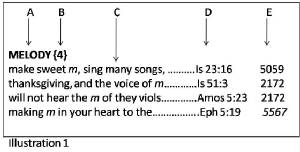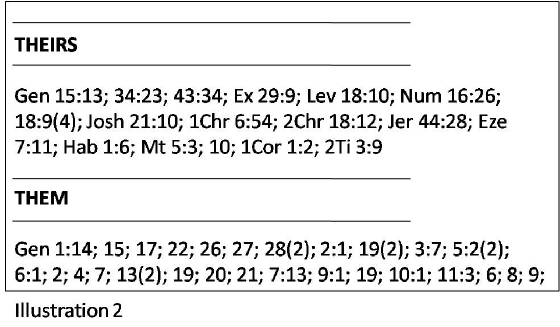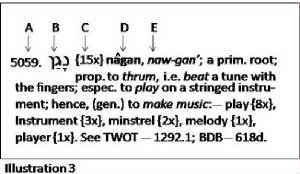|
|
|
Studying
your Bible without a concordance is like studying accounting without a calculator. With that said, let us begin the
lesson.
What is a Concordance?
A
concordance is a very useful tool for your studies. It is an alphabetical list of the words used in a book or important document
with references pertaining to where each word can be found within the book or document. Some concordances also provide the
meaning of each word. Because of the time, difficulty and expense involved in creating a concordance prior to
the computer age, only works of special importance, such as the Bible, Quran or the works of Shakespeare, had concordances
prepared for them. With the help of today's computers, more books and documents now have a concordance available.
What
is a Strong's Exhaustive Concordance of the Bible?
 Some Bible concordances only list main words found in a particular translation of the Bible while other concordances
contains a bit more information. Perhaps the most popular Bible concordance is the Strong's Expanded Exhaustive Concordance,
named after it's author Dr. James Strong. It is the bridge between the original languages of the Bible (Hebrew, Aramaic,
and Greek) and the English of the King James Bible translation. It is a book that lists every single word found in the King
James Bible, the book, chapter, and verse number of where each word can be found in the Bible, the number of times each word
appears in the King James Bible, and the definitions of each word. It also highlights the fact that many words in the original
languages of Bible have more than one meaning. It is a very powerful tool to have during your studies as it helps cut through
the maze of human opinions and hand-me-down theological suppositions by helping you understand the original meaning and content
of Bible words, passages, and stories as they were written in their original languages.
Some Bible concordances only list main words found in a particular translation of the Bible while other concordances
contains a bit more information. Perhaps the most popular Bible concordance is the Strong's Expanded Exhaustive Concordance,
named after it's author Dr. James Strong. It is the bridge between the original languages of the Bible (Hebrew, Aramaic,
and Greek) and the English of the King James Bible translation. It is a book that lists every single word found in the King
James Bible, the book, chapter, and verse number of where each word can be found in the Bible, the number of times each word
appears in the King James Bible, and the definitions of each word. It also highlights the fact that many words in the original
languages of Bible have more than one meaning. It is a very powerful tool to have during your studies as it helps cut through
the maze of human opinions and hand-me-down theological suppositions by helping you understand the original meaning and content
of Bible words, passages, and stories as they were written in their original languages.
How
can the Strong's Concordance Be Used?
The Strong's Concordance can be used to perform
words studies. For example, if you wanted to understand how the word love is used in the Bible, you would look up the word
love in the concordance, and make note of the different words used for love. You would then look up each Strong's Reference
Number for the word love in the Hebrew/Aramaic and Greek dictionaries located at the back of the concordance and write down
the meaning of each word translated love. After getting the meaning of each different word for love, go back to the concordance
page for the word love and look-up each Bible reference in your Bible to now see how the word love is used in the Bible. Get
ready for a tremendous blessing of spiritual insight! You may want to write either just above the word love or in the margins
next to the word love the original Hebrew or Greek word that was used in that particular text to help you remember the actual
definition that should be used.
The Strong's Concordance can be used to find a particular Bible
passage. For example, suppose you're trying to remember where the story of the rich man and Lazarus can be found. You
can look up a key word regarding the story, i.e., Lazarus, in your concordance to help you find it. There you will find every
occurrence where the name Lazarus can be found in the Bible, including book name, chapter and verse numbers, and a brief snippet
of the verse containing the name Lazarus. In this example you will learn that the story of the rich man and Lazarus can be
found in Luke chapter 16, verses 19-31.
One thing to keep in mind is that while the Strong's Concordance
is fairly reliable in its definitions, it is relying on 19th century scholarship. One of the best ways to determine the true
meaning of a word is look up that word in a Hebrew or Greek dictionary to see how it was translated in various places. Also,
Hebrew especially has various verb forms, tenses and stems that can have different meanings. The Strong's dictionary doesn't
do much to address this, but others (such as the Brown Driver Briggs that the online concordance uses) have more detailed
definitions for each verb stem.
How to use the Strong's Exhaustive Concordance of the
Bible
The concordance is divided into four sections - 1) the Main Concordance,
2) Appendix of Articles, Conjunctions, Prepositions, etc., 3) Dictionary of Hebrew Words, and 4) Dictionary of Greek Words.
1. Main Concordance
This is the actual concordance - the part of the
book that list the main words found in the King James Bible in alphabetical order (articles, conjunctions, prepositions, etc.,
are not listed in this section). In addition, it also list the number of times each word appears in the Bible, the Bible book,
chapter and verse number where each word is located, and the Strong's reference number of each word.
Example:
Look up the word melody in the concordance (see Illustration 1). The word is listed in bold (see Item A).
Next
to the word is a number in brackets (see Item B). This is the number of times the word melody can be found in the King James
Bible. In this example, melody is recorded 4 times in the King James Bible.
A brief snippet
of each Bible verse containing the word melody is provided under the word (see Item C). Only the first initial of the word
you looked-up will be listed in each snippet (the initial will be in italics). In this example you, since we looked-up the
word melody, only the m (for melody) will be listed in each Bible snippet.
Adjacent to
each of the Bible verse snippets are the Bible books, with chapter and verse numbers where the word melody can be found (see
Item D). In this example, you can find the word melody in Isaiah chapter 23 - verse 16, Isaiah chapter 51 - verse 3, Amos
chapter 5 - verse 23, and Ephesians chapter 5 - verse 19.
After the Bible book, chapter, and verse numbers
is the Strong's reference number (see Item E). This number is used for looking up the definition of the word in either
the Hebrew or Greek dictionary. If a Strong's reference numbers is in italics, that means that you should look up that
number in the Greek dictionary. Otherwise, look up the number in the Hebrew dictionary.

Each unique word in the King
James Bible is assigned a unique Strong's reference number. The same number is assigned to each occurrence of the word
if the word is the same. For example, in Illustration 1, the word melody is listed in the King James Bible 4 times, but it
only has 3 unique Strong's reference numbers (5059, 2172, and 5567). Notice that the word melody in Isaiah 51:3 has the
same reference number as the word melody in Amos 5:23 (number 2172). This means that the original word for melody in the Tanakh
(the Hebrew Bible) in Isaiah 51:3 is the same word that is used in the Tanakh in Amos 5:23. This is why they have the same
Strong's reference number. However, do not assume that since they are the same word, with the same reference number that
they must have the same meaning. Just like in the English language, the Hebrew and Greek languages also have homographs (words
that are spelled the same but have different meanings). Consider the English word fly. In the English language it could mean
to soar in flight through the air (as in flying through the air), or it could be an insect.
Likewise, do
not assume that if a word has two different Strong's reference numbers that this means that the word has two different
meanings. The Hebrew and Greek languages also have synonyms like the English language. For example, the Greek word for catch
has several Strong's reference numbers of which Strong's reference number 64, agreuo, and Strong's reference number
2340, thereuo, are synonyms - they have the same meaning. However, regarding our previous illustration, notice that the word
melody in Isaiah 23:16 is reference number 5059, while the word for melody in Isaiah 51:3 is reference number 2172. Reference
number 5059 means "to thrum, i.e., to beat a tune with the fingers; especially to play a stringed instrument; hence to
make music", while reference number 2172 means "a music piece or song to be accompanied by an instrument."
Now we know that the emphasis on the word melody in Isaiah 23:16 is to play a musical instrument (in this text it is specifically
referring to the harp), while the emphasis on the word melody in Isaiah 51:3 is to sing a song. Although the word for melody
used in Isaiah 23:16 is the same word used in Isaiah 51:3, they have different meanings. One is referring to playing a musical
instrument while the other is referring to singing a song.
There are hundreds of situations like this throughout
the Bible and sometimes the different meaning for the same word is much more dramatic - as in the Hebrew word for lad in the
King James Bible (Hebrew Strong's reference number 5288). This word is translated 76 times to mean a young man, 54 times
to mean a servant, 44 times to mean a child, 33 times to mean a lad, 15 times to mean young, 7 times to mean children, 6 times
to mean youth, 1 time to mean babe, and 1 time to mean boys. The point is - don't assume! Just because certain words may
be spelled the same does not mean that they have the same definitions.
2. Appendix
of Articles, Conjunctions, Prepositions, etc.

The Appendix section is a list of every non-main words, such as articles, conjunctions and prepositions (words such as and, because, but, he, she
the, theirs, them, etc.). Unlike the main concordance section, the appendix section does NOT provide a Strong's reference
number for these words, thus limiting the usefulness of this section. It does, however, tell you the Bible book, chapter,
and verse number where each word can be found in the Kings James Bible. For example, under the word THEIRS in Illustration
2, you will find this word in Genesis chapter 15 - verse 13, Genesis chapter 34 - verse 23, Genesis chapter 43 - verse 34,
Exodus chapter 29 - verse 9, etc. Each occurrence of where the word can be found is separated by a semicolon. If
no book or chapter number is
provided, this means that the word can be found in the previously listed book and chapter number. For example, for the word
THEM, the word can be found in Genesis chapter 1 - verse 14, Genesis chapter 1 - verse 15, Genesis chapter 1 - verse 17, etc.
Numbers that are in parenthesis indicates the number of times the word is used within a particular book, chapter, and verse.
For example, the word THEM is used twice in Genesis chapter 1 - verse 28, twice in Genesis chapter 2 - verse 19, twice in
Genesis chapter 5 - verse 2, etc.
3. Hebrew and Aramaic Dictionary
Words
in the dictionary section are listed in alphabetical order in their original language (Hebrew/Aramaic or Greek) and numerical
order by Strong's reference number. Therefore, in order to look up a word in the Strong's dictionary, you would need
to know how the word is spelled in it's original language or the Strong's Reference Number of the word you are looking-up.
For example, let's look-up the first occurrence of the word melody from Illustration 1- which is reference number 5059
in the Hebrew dictionary. We know to look in the Hebrew dictionary and not in the Greek dictionary because #1 - the reference
number is not in italics (reference numbers in italics are assigned to Greek words and therefore will be found in the Greek
dictionary); and, #2, the word is in the book of Isaiah which is in the Tanakh (Old Testament) of the Bible (see Item D in
Illustration 1). Remember, the Old Testament was originally written in Hebrew and Aramaic, and the New Testament was originally
written in Greek.
The following is an Illustration of reference number 5059 as it would
appear in the Hebrew/Aramaic dictionary:

Item A = the Strong's reference number as found in the concordance.
Item B = the
original spelling of the word - either Hebrew/Aramaic or Greek. In this case, it is the original Hebrew spelling of the word
translated as melody in the King James Bible.
Item C = The number of times the original word appears
in the original writing. There are a few things you need to remember about this number. First, it is the number of times the
original word, not the translated word, appears in the original writing. Second, the original word may have more than one
meaning. And third, you must remember the original writing is either the Hebrew Tanakh or the Greek New Testament.
Item
D = The Hebrew/Aramaic or Greek word represented in English letters (this is called the transliteration).
Item
E = the Strong's syllable-by-syllable pronunciation with the emphasized syllable marked by the accent.
Note:
for advanced word studies, a cross-reference to other lexicons is given at the end of the definition. These lexicons are the
Theological Wordbook of the Old Testament, and the Brown-Driver-Briggs Hebrew and English Lexicon. These two lexicons are
abbreviated as TWOT and BDB.
4. Greek Dictionary
The
layout of the Greek dictionary is the same as the Hebrew and Aramaic dictionary. It must be noted that the numbering of Greek
words skips number 2717 and numbers from 3202 to 3303. This error was done in the original edition of the Greek dictionary
and since that dictionary has been used by many other Bible reference works, it has been purposely left unchanged to avoid
the confusion that would result from having an old and new Strong's numbering system. No Greek words that Strong listed
in the original are missing from the current dictionary.
|
"These were more fair-minded than those in Thessalonica, in that they received
the word with all readiness of mind, and search the Scriptures daily to prove whether these things were so." Acts 17:11 |